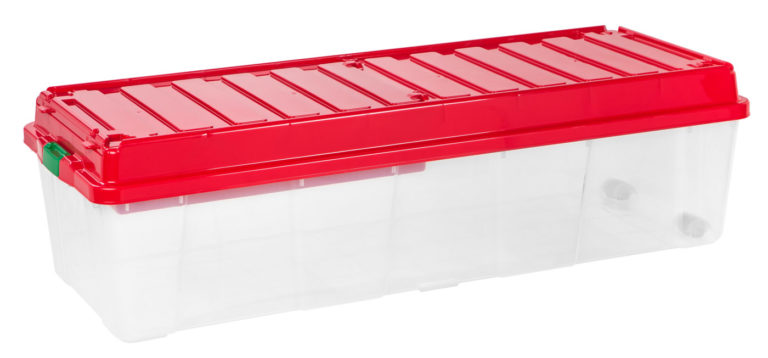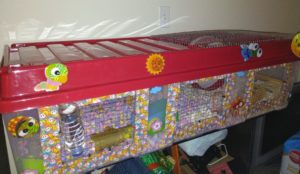Bin cages are hamster cages made out of storage bins. It is the cage of choice of many hamster owners. They are inexpensive, easy to make, easy to handle and they are stackable, by cutting windows on the sides and replacing them with 1/4 inch wire mesh. Our ONLY bin recommendations for hamster cages are the 50 gallon Sterilite bin, as the minimum bin option that meets our cage requirements, and the Iris Holiday Tree Storage Tote.
50 Gallon Sterilite Bin

The 50 gallon (200qt) Sterilite bin makes an excellent cage because it provides a lot of space and enough height to fit any size wheel, to add hammocks and various ramps. It is our 1st choice when it comes to bin cages.
It can be purchased at Walmart, Home Depot, even Target during the holidays, for around $25.
Because hamsters are little escape artists, you will also need to keep the lid on, which means that you will need to replace sections of the bin with hardware cloth or wire mesh for ventilation. You can also use wire playpen panels* for the lid and sides.
Water bottles* can be easily attached by either purchasing a metal water bottle guard, which will also protect your water bottle from chewing, or by using industrial strength Velcro*or magnets*. Other items, such as hammocks can also be attached by hanging them by the wire of the lid.
IRIS Holiday Tree Storage Tote

The IRIS Storage Tote makes an excellent hamster haven by providing over 800 square inches. However, it’s not as tall as the 50 gallon Sterilite bin and that causes problems with fitting in large wheels, like the 12 inch Silent Spinner. It is doable though with some modifications (raised mesh lid).
It can be purchased at Walmart or Home depot during the winter holidays for around $30.
Because hamsters are little escape artists, you will also need to keep the lid on, which means that you will need to replace sections of the bin with hardware cloth or wire mesh for ventilation. You can also use wire playpen panels* for the lid and sides.
Water bottles* can be easily attached by either purchasing a metal water bottle guard, which will also protect your water bottle from chewing, or by using industrial strength Velcro* or magnets*. Other items, such as hammocks* can also be attached by hanging them by the wire of the lid.
How to correctly measure a bin:
The dimensions provided by manufacturers do not always equal usable floor space, especially in the case of plastic bins. Always measure the bottom part of the cage, what would be the floor space used by the hamster.
- Take a measuring tape and turn the bin over
- Measure the length (L) and the width (W) of the bottom of the bin
- Multiply the length (L) by the width (W) and that will give you the usable floor space in sq inch (30″ (L) x 20″ (W) = 600 sq in.)
- Choose an enclosure high enough to fit a 12 inch feel (a minimum 15 inch in Height (H)

Hamster bin cage Diy
Providing ventilation:
In order for a bin to be used as a bin cage, it needs to have enough ventilation (no, just poking holes will not be enough). By cutting out a rectangular section out of the side of the bin or the lid (or both), and replacing it with wire mesh* (1/4 inch, no greater than 1/2 inch) or wire playpen panels*. It is very important that a hamster cage has enough ventilation because of the ammonia build up, which can cause respiratory issues.
Lid ventilation:
- recommended type of ventilation to be added because it allows for better ammonia dispersion (ammonia from urine rises up)
- it allows deeper bedding to be added to the bin
Front Side ventilation:
- recommended when you need to stack them
- it allows for better visibility inside the cage
- it provides greater visibility outside the cage and allows the hamster to interact with its environment
Supplies
You will need:
- a clear bin – 50 gallon storage bin or Iris Holiday Tree tote (listed above)
- galvanized steel hardware cloth* in ¼ inch, no greater than ½ inch, grid spacing or wire playpen panels*.
- a cutting tool: soldering iron*, oscillating tool*, jigsaw*, electric cut-off tool, hot knife
- wire cutters* to cut the wire mesh and remove any sharp edges that could harm your hamster (very important) and remove the zip tie ends at the end
- measuring tape*
- permanent marker*
- painter’s tape* to reinforce the outside of your cut and prevent the bin from cracking
- sanding block* to smooth out cut edges
- drill, with a drill bit slightly larger than the width of the cable ties, but smaller than the head of it (you can also use a soldering iron to make holes)
- zip ties*
- protective equipment: sturdy gloves, protection glasses and a mask (if using a soldering iron or hot knife)
You can purchase all these supplies online, or maybe even cheaper at your local hardware stores, like Home Depot or Harbor Freight Tools.

Instructions
- Using the measuring tape, measure the length (L) and the width (W) of the area you want to cut out and write them down. Mark the area on the bin by using the permanent marker. Important things to consider when deciding on the size of your cut:
- if you are going for a large cut, make sure you leave enough space (at least 1 inch) on each side for the holes and for the wire mesh or panels to properly cover the cut sides (to prevent escaping).
- if adding side ventilation, make sure there is enough height from the bottom to the lower cut in the bin to add a lot of bedding
- if using the playpen panels linked above, you can cut the bin at 24.5 inch length (L) and 7.25 inch in width (W) and use 2 connected panels for each cut.
- If using an electric cutting tool like a saw, oscillating tool etc, use painter’s tape to seal plastic on the outside of your cut (the part of the bin that will remain). This will prevent the bin from cracking. Also leave the tape one while drilling holes as well.
- Make your cut using the cutting tool of your choice. Make sure to use any protective equipment you have. The last thing you want to do is hurt yourself. Also, make sure to use a properly ventilated area, preferably outside and away from any pets, because of the fumes caused by cutting the plastic.
- Sand down the rough cut edges. You will notice that no matter what cutting tool you use, there is melting of the plastic because of the heated pressure of the cutting tool. This will cause rough edges.
- Prepare the wire mesh for cutting, but first determine the measurements by adding 2 inches to the length (L) and 2 inches to the width (W) of your cut that you wrote down in your initial step.
- Using the wire cutter, slowly cut the wire mesh, making sure you keep a clean edge by angling the wire cutter. If using the playpen panels linked above, you won’t need to cut anything.
- Place the wire mesh over the opening and mark the holes to be drilled using the marker, around 3 inches apart and 3/4 inch away from the edge of the cut. You can use a drill or a soldering iron to make holes in the plastic. If using the drill, choose a drill bit of the same size or slightly larger than the zip tie.
- If using wire mesh, fit the cut wire mesh over the cut on the outside of the bin (in case there are rough edges that could harm your hamster). If using wire panels place them on the inside of the bin to prevent chewing on the plastic edge of the bin.
- Zip tie everything and cut the zip tie ends with the wire cutter, making an angled cut to prevent any sharp edges.
* We participate in the Amazon Affiliate Program and we might earn a small commission on products ordered through our website.


